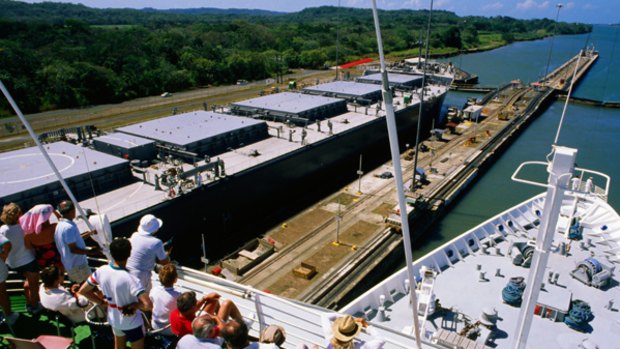
Incredible ... passengers watch as their ship passes through the gates of a lock.Credit: Wayne Walton/Lonely Planet
They zig, you zag - the Panama Canal is where real ships meet, writes Shaney Hudson.
My first glimpse was from above. We flew down the continental divide, banking left to reveal the Caribbean Coast, before the plane turned right towards the sprawling metropolis of Panama City.
Container ships dotted the bay like rectangular polka dots. And that thin, dark zigzag cutting the country in two, joining the Atlantic with the Pacific, was the Panama Canal.
Not only did the canal revolutionise shipping, its construction was a drama of epic proportions involving countries, personalities, war and the death of about 25,000 workers.
I'd assumed the only way to navigate the canal was either as cargo crew or by booking a passage on a luxury cruise. However, an affordable alternative is a four-hour partial transit on the Pacific Queen, a 35-metre cruiser custom-built for day trips with lunch, drinks and a guide on hand.
As we set off from the mouth of the River Chagres, I was a bit disappointed. The waters there are murky and putrid-smelling. From the upper deck, there is little to distinguish this as one of the great engineering feats of the 20th century. My mood changed, however, when a vast shadow engulfed our boat, blocking out the sun. Just metres away, a Panamax tanker silently slid past, stacked high with containers that looked like large Lego pieces.
The Panamax was 10 times the length of the Pacific Queen and five times heigher. I was in awe - the canal now had my undivided attention.
We passed the vessel at Gold Hill, which at 200 metres marks the continental divide. Visually striking, the hill has been carved down the middle and is the narrowest section of the canal. During its construction there were frequent landslides, almost as if the isthmus was resisting being split in two. I can't help but think that man wasn't meant to slice through the centre of a country and squeeze giant tankers through it. But somehow we've managed to succeed.
After Gold Hill, our first step down to the Pacific was at Pedro Miguel Lock. Our vessel motored into the lock and the gates were swung shut behind us. We felt like a rubber ducky in a concrete tub. An invisible hand pulled the plug and we began to sink as the water emptied out.
Some passengers set their watches to time how long it takes; others go mad taking happy snaps. Most just watch in astonishment as the canal's workers nonchalantly stroll across the gates just as they begin to open.
Our guide explained that ships pay by weight for passage, with the most expensive transit costing more than $US184,000 (about $272,000). The lowest price paid was by Richard Halliburton, who swam the length of the canal in 10 days. He paid 36 cents and had to be shadowed by a support boat so he didn't get chomped by the caimans - local crocodilian reptiles that call the canal home.
While the big boats can only transit safely in one direction at any time, smaller boats are allowed to pass in either direction. A traffic jam of pleasure craft meant we had to wait our turn, so we retreated to the air-conditioned comfort of the lower decks to indulge in that all-important cruise staple: the buffet lunch.
The final barrier on our voyage to the Pacific Ocean was Miraflores Locks. We felt like rock stars as we entered the first of two locks and hundreds of people waved at us from the viewing platform. We soon felt insignificant again when a super tanker slid into the lock next to us. By Panama Canal standards, we were just small fry.
Sailing forward into the second lock, the Pacific Queen jammed in along the concrete side of the wall. From the upper deck I could easily reach out and touch the cold, pock-marked wall, now brushed with the paint-scrapes of thousands of vessels.
Eventually our crew (with the help of a few enthusiastic passengers) managed to push our boat away from the wall and we sailed out of the lock into Balboa Harbour.
Entrepreneurial pelicans lay in wait. The locks empty more than 50 million gallons of fresh water into the harbour with each transit. Any fresh fish trapped in the locks are flushed into the salty Pacific and immediately float to the top, providing an easy dinner for opportunistic birds.
The Panama City skyline greeted us as we rounded into Flamenco Marina, the high rises and luxury apartments a glittering oasis of comfort in the middle of Central America.
The canal is clearly a source of great wealth for the country and, given its burgeoning growth, you'd expect that poverty would not be an issue. However, in the huge intersections that punctuate Panama's modern city, the children selling batteries and chewing gum through taxi windows show that the wealth generated by the canal doesn't reach everyone.
Despite this, the canal is one of the world's greatest achievements. A partial transit is a must for any boat buff, engineering afficionado or for anyone who just likes to muse and wonder at man's bold schemes. We're a clever lot, aren't we?
TRIP NOTES
Getting there
Several major airlines fly from Sydney to Los Angeles. From there, Copa Airlines flies daily to Panama City with return fares starting at $432 (including taxes). Alternatively, several cruise lines include the canal as part of their itinerary, beginning in Florida and ending in LA (or the reverse).
Cruising there
Partial transits of the canal cost $115. A full transit is available once a month. See pmatours.net. Admission to the Miraflores Visitors Centre is $US3 ($4.50).
The Sun Herald
Sign up for the Traveller Deals newsletter
Get exclusive travel deals delivered straight to your inbox. Sign up now.